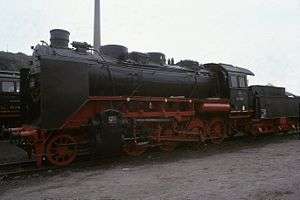Prussian G 8.2
The Prussian G 8.2 class of locomotives actually incorporated two different types of engine: One was the Prussian/Oldenburg G 8.2, for which the Deutsche Reichsbahn subsequently issued follow-on orders; the other was the G 8.2 of the Lübeck-Büchen Railway.
Prussian G 8.2
| Prussian G 8.2 DRG Class 56.20–29 | |
|---|---|
| Number(s) | DRG 56 2001–2485, 2551–2916 |
| Quantity | 846 |
| Year(s) of manufacture | 1919–1928 |
| Retired | 1970s |
| Wheel arrangement | 2-8-0 |
| Axle arrangement | 1'D h2 |
| Gauge | 1,435 mm (4 ft 8 1⁄2 in) |
| Length over buffers | 16,995 mm |
| Service weight | 83.5 t |
| Adhesive weight | 70.2 t |
| Axle load | 17.7 t |
| Top speed | 65 km/h |
| Indicated Power | 1,022 kW |
| Driving wheel diameter | 1,400 mm |
| Leading wheel diameter | 1,000 mm |
| No. of cylinders | 2 |
| Cylinder bore | 620 mm |
| Piston stroke | 660 mm |
| Boiler Overpressure | 14 bar |
| Grate area | 3.42 m² |
| Superheater area | 53.12 m² |
| Evaporative heating area | 164.15 m² |
| Tender | pr 3 T 16.5/20 pr 2'2' T 21.5 |
| Water capacity | 16.5/20.0/21.5 m³ |
The Prussian G 8.2 was a 2-cylinder version of the Prussian G 8.3. It had been established that the inside third engine of the G 8.3 was not absolutely necessary and discontinued the G 8.3 as a consequence. Like that engine the G 8.2 had been developed from the G 12 and was in essence a shorter version of it. The locomotives were employed on heavy goods train duties on main lines. Later the top speed on some units was raised to 75 km/h so that the G 8.2 could also be used to haul passenger trains. A totoal of 846 examples of the locomotive were built between 1919 and 1928 for the Prussian state railways and the Deutsche Reichsbahn. Five vehicles, that had been delivered in 1921 to the Reichsbahndirektion of Oldenburg, had been equipped with Lentz valve gear as was usual on the Oldenburg machines. The locomotives delivered in 1922 were Cassel division numbers; in 1923 several were supplied as DRG Class 31 before they were allocated their eventual DRG numbers in 1923. Another 150 vehicles were supplied to the Turkish and Rumanian railways. The firm of AEG converted four engines to coal-dust firing in 1930. 650 examples of these locos were still present in Germany after the Second World War. The Deutsche Reichsbahn had given them operating numbers 56 2001–2485 and 2551–2916.
In the Deutsche Bundesbahn this class was very quickly retired; the last one to go being no. 56 2637, withdrawn in 1963 and retired in 1965. The Deutsche Reichsbahn in East Germany used these locomotives right up to the early 1970s - a number even being given computer numbers. Its last stronghold was Bw Vacha in Thuringia, which had both the first and last engine to be built: nos. 56 2001 and 56 2916. In Germany no Class 56.20–29 has been preserved. No. 56 2795 is in the Warsaw railway museum as no. Tr6-39.
Link: Ehemalige 56 2795 in Warschau
G 8.2 of the LBE
| G 8.2 (Lübeck-Büchen Railway) DRG Class 56.30 | |
|---|---|
 | |
| Number(s) | DRG 56 3001-3008 |
| Quantity | 8 |
| Manufacturer | Linke-Hofmann |
| Year(s) of manufacture | 1923-1930 |
| Wheel arrangement | 2-8-0 |
| Axle arrangement | 1'D h2 |
| Gauge | 1,435 mm (4 ft 8 1⁄2 in) |
| Length over buffers | 18,645 mm |
| Service weight | 79.4 t |
| Adhesive weight | 70.98 t |
| Axle load | 17.66 t |
| Top speed | 75 km/h |
| Driving wheel diameter | 1,400 mm |
| Leading wheel diameter | 1,000 mm |
| No. of cylinders | 2 |
| Cylinder bore | 620 mm |
| Piston stroke | 660 mm |
| Boiler Overpressure | 14 bar |
| Grate area | 2.63 m² |
| Superheater area | 51.70 m² |
| Evaporative heating area | 152.5 m² |
| Tender | pr 3 T 16.5 |
| Water capacity | 16.5 |
The G 8.2s with the Lübeck-Büchen Railway were certainly similar to the Prussian G 8.2s, but were in fact an independent design with numerous differences. For example, they were noticeably longer and did not appear quite as stocky. They were intended to take charge of heavy goods trains running between Hamburg and Lübeck. Because these locomotives were also to be used in passenger services, the running gear and brakes were designed so that the top speed could be raised to 75 km/h. A total of eight engines was delivered between 1923 and 1930 by Linke-Hofmann. In 1938 they were given Reichsbahn numbers 56 3001-3008.
The Deutsche Bundesbahn took over locomotives 56 3001 and 56 3003-3008 and retired them by 1951. No. 56 3002 was left to the Deutsche Reichsbahn (GDR) in the east, who retired her in 1956.
Locomotive 56 3007 has been preserved and is in the Darmstadt-Kranichstein Railway Museum.
The engines were equipped with tenders of classes pr 3 T 16.5, pr 3 T 20 or pr 2'2' T 21.5.
See also
References
| Wikimedia Commons has media related to Prussian G 8.2. |